Ever heard the saying “up a creek, without a paddle?” If you have, then you know there’s usually a curse word in there that implies the trouble you may have found yourself in. An oar and a paddle are two terms interchangeably used.
But did you know that a paddle and an oar are different tools?
While both are used to propel boats through water, the key difference is their design, function, and usage. Let’s explore the difference between oar and paddle to ensure you’re prepared for your next adventure!
What Is an Oar?

An oar is a long, slender pole with a flat blade on one end and a handle on the other and is used by pushing against the water in a rowing motion using two oars.
An oar propels a boat forward by pushing the blades against the water’s surface. An oar tends to be longer and features wider blades, making them better suited for generating power and ideal for competitive rowing.
What Is a Paddle?

Unlike rowing oars, a kayak paddle functions more like a spoon, scooping up water to propel the boat forward. A paddle blade is shorter and often includes a paddle leash in the equipment, with double-bladed paddles.
Differences Between Oars and Paddles
Let’s get into nitty-gritty details to learn more about their differences.
Boats They’re Used For
An oar is typically associated with traditional rowing boats and sweep oar boats, while a paddle can be used as equipment in a variety of other watercraft types.
However, an oar and a double-blade paddle have exceptions – some canoes or kayaks use oars instead of paddles due to their longer length and ability to generate more power. In addition, an oar is typically used by two or more people working together, while a paddle is often used by a single person.
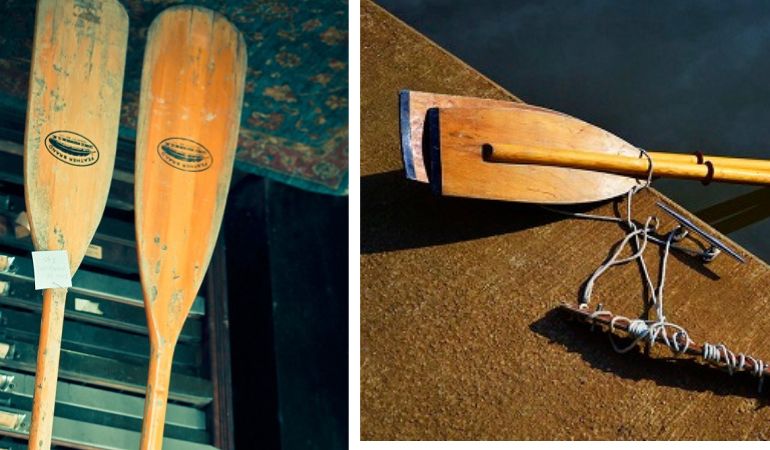
Technique and Muscles Used
Rowing oars are typically made of wood or a composite material, while a paddle may be made of wood, plastic, carbon fiber, or metal.
In terms of technique, rowing oar blades requires more strength, core muscles, and endurance than kayak paddles do, as they are pushed against the water in order to create forward momentum.
An oar is typically used in rowboats using a forward stroke, and a rowing technique requires repetitive strokes against the resistance of the water. As a result, rowing oars require strong upper body muscles like biceps, triceps, and back and arm muscles supporting to propel the boat forward.

Because oar strokes are slower and more consistent, rowers must use their leg muscles as well as their arm muscles in order to propel their boats forward. An oar requires significantly more strength to operate than paddles do, as they must be pulled using the entire body, like on a rowboat, rather than just arms and shoulders like paddles.
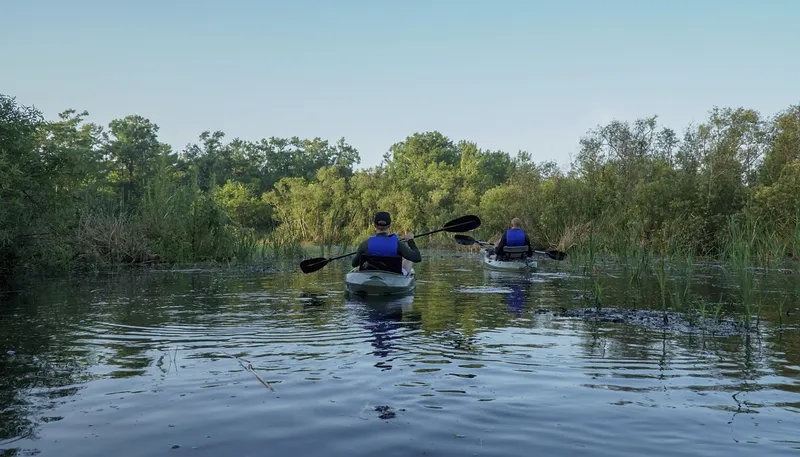
Thus, working out on a stationary rowing machine is a great way to burn calories, but why sit in an enclosed room when you can do it while enjoying a lake view?
A kayak paddle will use mostly upper body strength to move their boats through the water. It’s great to learn how many calories kayaking burn since its an amazing workout! A paddle typically has a longer blade on each side of a shorter shaft and is used more like an ice skate to slide across the surface of the water.
When comparing a paddle to an oar, a paddle uses more repetitive strokes per minute than oars, using arm muscles.
Design & Appearance
The main difference between a paddle and an oar is in their use. An oar is designed to be used in an up-and-down movement to propel a boat through the water, whereas recreational paddling can be used either in an up-and-down motion or in a side-to-side motion for greater control.
This makes an oar better suited for rowing, while a paddle is better suited for navigating in more narrow waterways or rivers. Another paddle comparison is their shape. An oar tends to be longer and thinner, while a paddle is shorter and wider.

Unlike paddling, oars have a greater surface area ideal for moving through the water, allowing them to move a boat at greater speeds.
In contrast, using a paddle vs. an oar allows you more control over your movements, giving you more options when navigating tight spaces or flowing currents. A paddle excels at moving vessels in the opposite direction, making tight turns due to their smaller size and greater surface area.
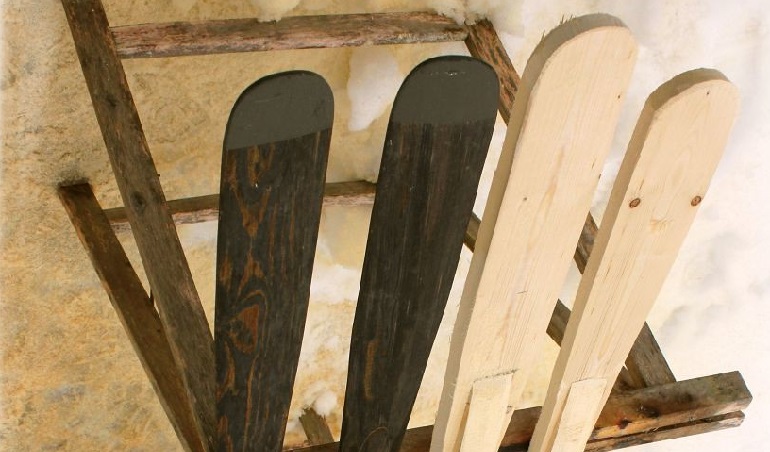
Materials & Construction
In order to compare oar vs. paddle, let’s look at their material and construction. An oar has a flat blade and is made of long pieces of wood or metal, while paddles are shorter and wider and typically made of lightweight materials like fiberglass, aluminum, wood, or plastic.

An oar is much longer than a paddle, typically ranging from six to ten feet in length.
This makes them more suited for use in large bodies of water, where there is plenty of room to row and make wide strokes, and change direction.
Double-blade paddles, on the other hand, tend to be shorter, with lengths between two and five feet, and are often used by kayakers and similar vessels. This makes them ideal for maneuvering a narrow watercraft or sup paddleboards in any direction where you may need to navigate tight turns or avoid obstacles.
Oars are typically held with two hands on either end of the oar, while single-bladed paddles are typically gripped at one end.

Stroke Technique
Between oars and paddles, different strokes are used. An oar stroke, called a rowing stroke, uses long, sweeping strokes, while a paddle stroke is more precise and controlled. An oar requires you to use your entire arm, from your shoulder down to your hand.
Oars are ideal for larger boats that need to travel at higher speeds. Most oars propel forwards or backward in a straight line.
In contrast, paddles can be used with either one or both hands, which is ideal for paddle boarding. Paddlers have precise control over their movements, helping them navigate tight spaces or maneuver around obstacles.
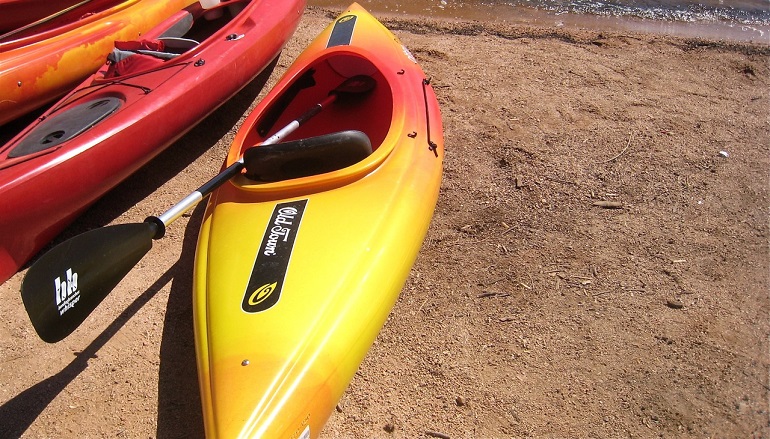
Speed
Oars are typically heavier than paddles, making them slower and less maneuverable in the water, but they are still capable of use for sports like kayaking or on paddleboards. However, oars typically offer more control, making them ideal for use in a racing vessel.

Weight
Paddles are shorter and wider than oars, making them lighter and easier to use for a vessel, such as canoeing or kayaking, where speed is not necessarily a priority.
Additionally, many modern designs feature ergonomic grips for kayakers and paddlers, making them more comfortable to use for long periods of time.
Performance
In terms of performance, oars tend to be faster than paddles overall due to the fact that they create a larger amount of water resistance with each stroke, while paddles move the vessel through the water more easily.
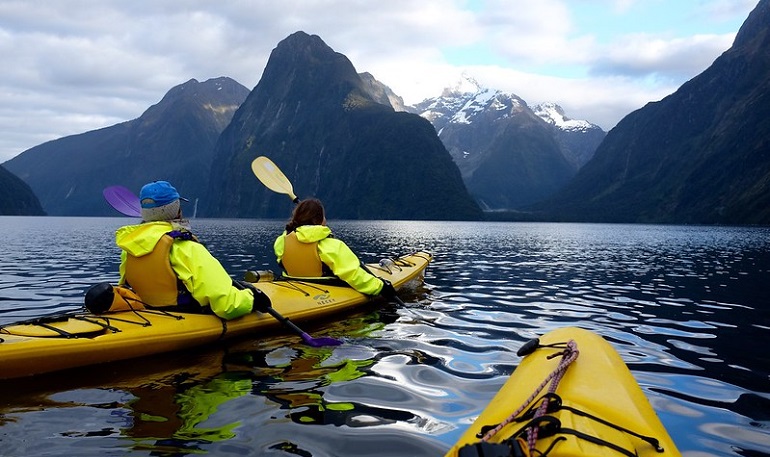
However, this can also make oars more difficult to control, especially in windy or choppy conditions.
Cost
Unlike oars, double-blade paddles tend to be cheaper upfront, they can also be less efficient, but if you are looking for a more affordable option that is ideal for the smaller vessel, then they might be the better choice.
Maintenance
Maintenance of paddles and oars is very different. One oar is much heavier than a paddle, so they require more upkeep in order to prevent damage from corrosion and wear. Paddles and oars are similar, but paddles are less prone to damage.
Oar Vs. Paddle Summary
Overall, oars are better suited for experienced boaters who need reliable propulsion, while paddles are typically preferred by less experienced paddlers or for sports like kayaking.
They have advantages depending on your needs as a boater, but both are essential for exploring the waterways around you!
0 Comments